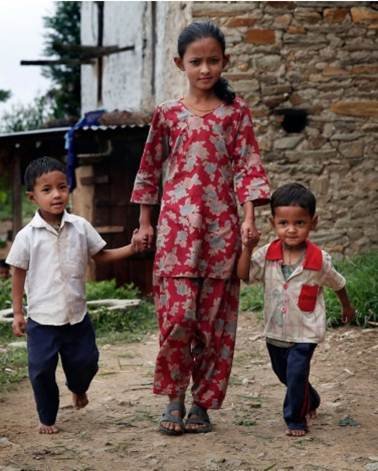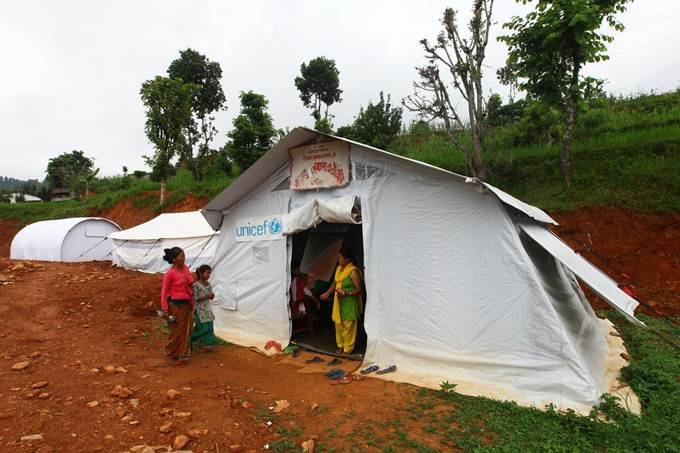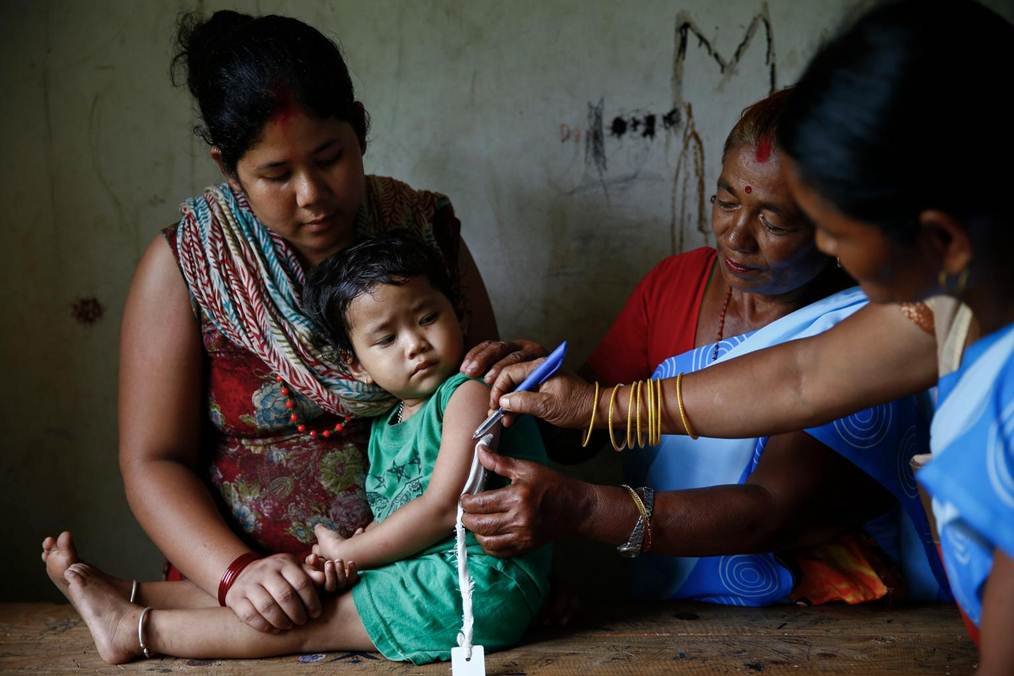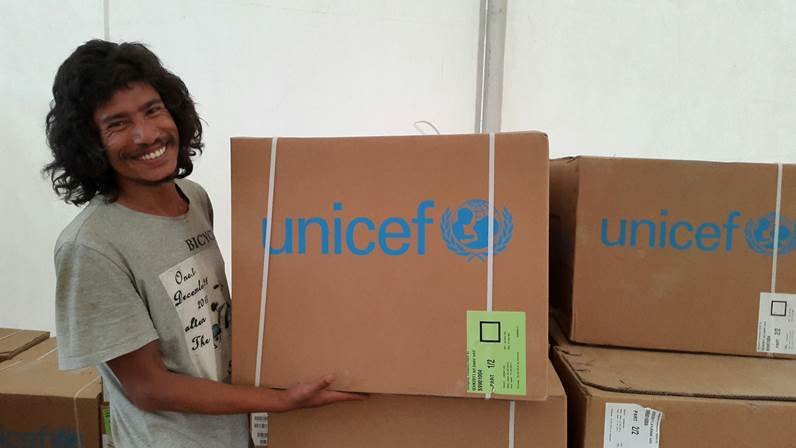By Rachel Steinberg, U.S. Fund for UNICEF | Assistant Director, Civil Society Partnerships
One month after two major earthquakes devastated Nepal, one in six children in the country are still in urgent need of humanitarian assistance - with increasing risk of chronic physical and emotional conditions.
Food, water and shelter are still the top priorities for aid in the affected districts. In the past month, UNICEF has worked with partners to distribute tents, tarpaulins, hygiene kits, therapeutic foods, medical kits, information/education/communication materials, plastic buckets, school-in-a-box and early childhood development kits. To date, the total value of UNICEF supplies distributed amounts to $3.8 million, with a $17.6 million plan for more supplies while $13 million worth of supplies have been ordered.
The need for drinking water and repair of water supply sources has also been very evident in rural villages. To address this, UNICEF has made clean water available to over 305,100 people and more than 45,200 now have access to adequate sanitation and hand washing facilities. To fight against diseases, UNICEF is also carrying out a major measles and rubella immunization campaign for more than 500,000 children.
In addition to children’s immediate physical needs, the psychological impact of experiencing two earthquakes in less than three weeks cannot be underestimated. There has been an increasing need for safe spaces for children to be together, interact and play, feel supported and receive psychosocial support. To address this, UNICEF has been working with partners to set up 65 Child Friendly Spaces for more than 10,000 children in displaced communities. To help children regain a sense of normalcy, temporary learning centers for more than 950,000 children are being established.
Although relief efforts over the past month have helped to save the lives of many children in Nepal, the enormity of the task ahead to heal both emotional and physical scars is tremendous.
Situation Overview
On April 25th, 2015, twelve days after the Nepali New Year, a powerful 7.8 magnitude earth- quake struck Nepal with its epicenter in Lamjung, 50 miles (80 km) west of the capital Kathmandu.
Devastatingly, a second earthquake with a magnitude of 7.3 struck on May 12, 2015. This earthquake, with its epicenter in Dolakha District (east of Kathmandu) exacerbated the destruction and worsened living conditions for people, particularly in the most severely affected districts such as Sindhupalchowk. The second earthquake also led to further destruction of educational facilities and health infrastructure.
Out of the 22 most affected districts, the Government has prioritized and classified 14 districts as severely affected. These districts have an estimated population of 2.7 million, of which an estimated 1.1 million (40 percent) are children below the age of 18 years.
Working Together to Provide Relief
On April 27th, the UNICEF Executive Director declared the situation in Nepal following the first earthquake a Level 2 humanitarian emergency situation, based on an analysis of scale, urgency, complexity, reputational risk and capacity.
Most international humanitarian efforts are being coordinated through the Humanitarian Country Team. Some donor countries are also providing substantial direct assistance to Nepal through the provision of medical teams, technical expertise, equipment and other logistical means (e.g. air assets; vehicles; warehousing capacity).
The Government of Nepal has repeatedly emphasized the importance of coordination with district level government officials (Chief District Officers) for aid delivery. Transparency is also required on data sharing pertaining to donations and relief spending.
UNICEF in Action
Water, Health and Sanitation (WASH)
UNICEF’s target is to reach 840,000 people with WASH interventions through the government and other partners. This includes supplying people with safe water of appropriate quality for drinking, cooking and personal hygiene, providing access and use of adequate sanitation and hygiene facilities including hand washing facilities and bathing spaces as well as the provision of hygiene kits and hygiene education and materials through interpersonal communication.
UNICEF Achievements:
Education
The Education cluster is mobilizing to restore access to education as soon as possible. Temporary Learning Centers (TLCs) for children 3-18 with gender-sensitive WASH facilities have been set up. Teachers have been oriented to provide psychosocial support and key life- saving messages. UNICEF and partners are also aiming to reach more than 1.5 million children with education supplies, and are supporting the government-led “Back to School” campaign to re-start interrupted schooling, assess damaged school structures, and prepare for the monsoon.
To help restore the education system and to build back better, UNICEF will support the government to undertake data collection and analysis to feed into a Post Disaster Needs Assessment to ensure a targeted needs-based reconstruction, supporting the government’s Annual Strategic Implementation Plan and the next multi-year Education Sector Plan from 2016 onwards.
UNICEF Achievements:
Nutrition
The Nutrition cluster was set up to assess the situation and respond to immediate needs. Based on assessments, the cluster focused its efforts on protecting and supporting breastfeeding, impeding the arrival/use of unsolicited donations of breast milk substitutes, promoting life-saving feeding practices for infants and young children, improving the quality of complementary foods for children under-two, distributing supplements of essential micronutrients to children, pregnant women and breastfeeding mothers, and preventing and treating severe acute malnutrition.
In the next few months, focus will shift towards ensuring that district level governments, communities and families can provide for the long term nutritional needs of the most vulnerable children and women in the worst affected areas.
UNICEF Achievements:
Child Protection
The vision of the Child Protection sub- cluster response is to make sure vulnerable children do not fall victim to trafficking and violence, and that they properly recover from the emotional shock of the earthquake.
The response to date has focused on preserving families, identifying unaccompanied and separated children, responding to psychosocial distress through community based support services and specialized care, and preventing children and women from being trafficked. Working with government and other partners, the cluster has given particular attention to marginalized groups, such as children with disabilities.
UNICEF Achievements:
The Way Forward: Rebuilding for Future Generations
UNICEF envisions a brighter future for children in Nepal – healthier, better educated, adequately nourished and more resilient to future disasters. To do this, UNICEF is working with partners to:
Forge grassroots networks: To reach the most vulnerable children, UNICEF will open a few new zonal offices and strengthen a network of partners at the village level, ensuring sustainable and long-term programming in hard to reach areas.
Apply an integrated approach: In leading and co-leading humanitarian clusters in Education, Nutrition, WASH and Child Protection, UNICEF’s strategies apply a holistic programmatic approach. For example, in Dolakha, UNICEF and government partners employed a rapid integrated response where all the programs came together to implement holistic rebuilding and response interventions.
Link relief with recovery: UNICEF is working with the government to ensure that permanent solutions are found. It is working to build the resilience of communities in this area by incorporating Disaster Risk Reduction across all programmatic sections. To further facilitate recovery, UNICEF is implementing a cash transfer system to revive the market economy, especially at the village level.
Innovate for the long term: UNICEF will continue to apply creative solutions in its long term response, for example by using real time reporting for immediate and effective solutions, SMS and bar coding for logistics tracking, using national and community radios to provide psycho social support to children, and implementing the U-report system, enabling people in severely affected districts to provide feedback on the response.
UNICEF is committed to ensuring that children grow up with access to the full range of services they need, allowing them to reach their full potential to contribute to the development of their nation.
Links:
Project reports on GlobalGiving are posted directly to globalgiving.org by Project Leaders as they are completed, generally every 3-4 months. To protect the integrity of these documents, GlobalGiving does not alter them; therefore you may find some language or formatting issues.
If you donate to this project or have donated to this project, you can receive an email when this project posts a report. You can also subscribe for reports without donating.



